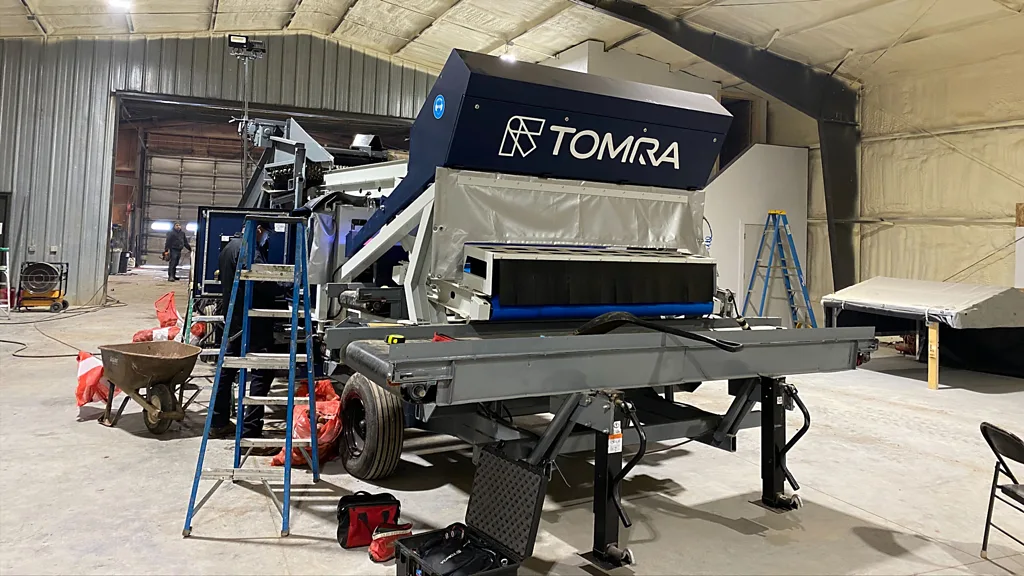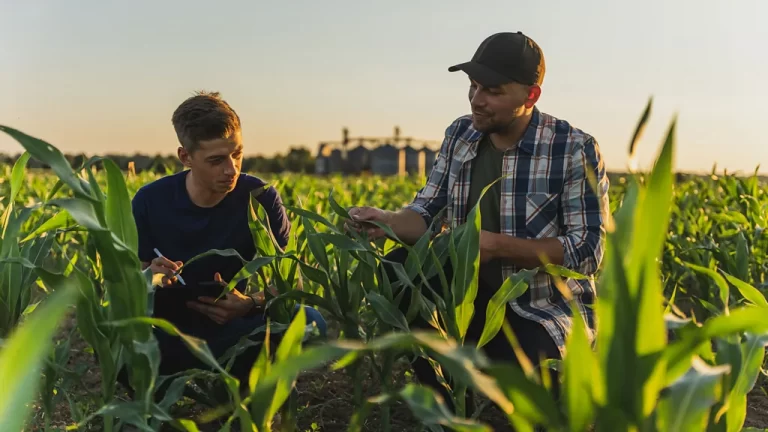American farmers are rapidly ploughing ahead with adopting artificial intelligence. The technology is as sophisticated as it is essential.
Standing in a lush green field in the American Midwest, a farmer points his smartphone at one of his soybean plants. He snaps a photo of a pest crawling a leaf, then lets an AI-driven programme name the species of the bug, and whether it's a cause for concern. Technology like this might sound like a novelty – but it is vital.
Across agriculture, a dearth of workers is threatening the viably of the industry, both in terms of profitably and crop yield. There simply are not enough hands to sustain the food systems that feed the world. This is particularly a problem in the US, which produces the third-largest agricultural output behind China and India.
One of the biggest issues is simple: farmers are getting older. Many can't take on the sun-up-to-sundown manual labour needed to effectively run a farm. And while many these operations have been family-run for decades, younger generations aren't taking the reins from their elders as they once did, instead opting for jobs in less labour-intensive, better-paying industries. The hired labourers who make up the rest of the agricultural workforce, largely immigrants, are following these patterns, too.
“Labour is the number one concern,” says Emily Buckman, director of government affairs at the American Farm Bureau Federation, an industry trade association. “The average age of a farmer now is 60. Buckman herself grew up on a farm in Kentucky, where her 70-year-old father still works the soil, with only her brother to hlp him.
To solve the problem – especially as the worker pool is not only thinning but also getting more expensive, and crop yields are declining – some US farmers are looking to emerging robotics and AI tools. “We think about solutions to solving that problem, and we do think that advances in technology could help ease some of the labour load,” says Buckman.
Artificial intelligence in agriculture is not wholly new: nascent iterations have been in use for two decades, like auto-steering guidance systems to row crops such as corn. But AI take-up in the past few years has been swift; according to some estimates, 87% of businesses in the US agricultural industry were using AI in some shape or form as of late 2021. The federal government, too, is currently fast-tracking the agriculture industry towards the tech, providing financial incentives to speed up development and deployment of AI across the country.
If the push to adopt AI across the nearly two-million American farms succeeds, the implications for the rest of the world could be substantial. This is especially the case as the number of mouths to feed across the globe grows, and climate change threatens the agriculture ecosystems of some of the largest producers on Earth – including the US itself, which exported more than $100bn (£78.9b) of products to China, Mexico, Canada and Europe last year alone.
The industry's goal is to develop and adopt new technology on a mass scale that is both affordable and accessible “so that farmers can feed the world”, says Buckman. “The world population is supposed to increase by two billion by 2050, which means we're going to need to grow 70% more food than we do now. Innovative technology is going to help us do that.”
‘A great deal of promise'
There is a lot of pressure for the agriculture industry to find solutions – and fast. The US labour shortage has already forced these operations to do more with less. But the urgency of the climate crisis is the tipping point. Erratic weather has made it more difficult to predict growing conditions, and is also hurting crop yields. In other words, hotter weather could lead to less food, sooner than expected.

“All projections show major losses in crop yields due to climate change,” says Patrick Schnable, a distinguished professor at Iowa State University, where he directs the Plant Sciences Institute. “A 10% or 20% reduction in corn yields would be catastrophic,” he says. So, the question is: “Can we use AI to increase resiliency?”
Iowa State is home to the AI Institute for Resilient Agriculture, which works to create AI-driven tools and technologies with partner institutions across the US, and is supported by the National Science Foundation (NSF) and the United States Department of Agriculture (USDA).
“Our focus is looking at two broad problems,” says Schnable. “One is sustainability identification – how do you design new activities that are related to agriculture and resilient to climate change,” he says. “The second thing is, how can AI, robotics and sensing [tools] enable more profit for farmers, less utilisation of resources, energy, chemicals and water.”
Baskar Ganapathysubramanian, director of the AI Institute for Resilient Agriculture, and a professor in the mechanical engineering department at Iowa State University, says that in terms of tackling those two goals, “there's a great deal of promise, and some of it's already being implemented”.
Currently, Buckman says drones and GPS tools are the most widespread AI tools on the market. But there are many others, too, such as self-driving tractors and combines, and even quality sensors on those machines that can help farmers determine which parts of their crops need more or less attention.
There are also robots that can do automated sorting tasks that previously required a human eye. For instance, some farms are leveraging AI tech to sort potatoes, looking for specific defects. Others are using AI-enhanced cultivators to plant seeds and remove weeds from fields, which can effectively replace dozens of human workers.
Fertile soil for AI
Using AI to reduce the quantity of resources used, while also improving crop yields, is a part of a larger strategy experts refer to as “precision agriculture”. The idea is for farmers to use emerging technologies – say, drones that assess a field's water or pesticide levels – to address problem areas with surgical precision.
“Precision agriculture helps reduce water waste, be more efficient and do more with less,” says Buckman. “US agriculture would've needed 100 million more acres 30 years ago to match today's production levels,” she says. The production improvements are largely due to precision ag strategies being used in tandem with AI and other tech.
Many of these advancements have been pioneered and deployed at scale by major players in the global agricultural space. Among them is Illinois-based John Deere, which develops and manufactures tractors and other tech tools for use in agricultural operations across the world.
“Our goal with AI and technology is to help farmers do their jobs better,” says Sarah Schinckel, John Deere's director of emerging technologies in the Intelligent Solutions Group (ISG). AI tools are “changing farming, it's already here, and farmers are adopting it”, she says. “We see a future where more and more farmers are using this technology.”
Schnickel says John Deere has had many AI tools available to farmers for decades, such as its Autotrac tools, which allow for hands-free combine steering. They're only advancing as technology gets more sophisticated. In 2018, the company introduced See & Spray tech, which “adds AI to the machines” and helps farmers find and remove weeds within crops, and apply herbicides only where needed at an incredibly granular level. That tech has enabled farmers to reduce herbicide use by as much as 66%, says Schnickel, reaping considerable savings. “There's a clear ROI for a lot of this stuff,” she adds.
John Deere also unveiled fully autonomous tractors within the past couple years, too. Those tractors, says Schnickel, are the next big step toward a larger vision for farm autonomy, which should accelerate in the next several years. “We have goals by 2030 to bring autonomy to all production steps,” she says.
Reaping the AI harvest
Lowering costs and increasing yields are of obvious importance to American farms and agricultural companies, but the benefits reach far further and could reverberate across the world.
“Improved productivity in the fields means more profit for farmers, a more robust supply chain and lower prices for consumers,” says Steven Thomson, the national programme leader of Agricultural and Biosystems Engineering, Institute of Food Production and Sustainability, USDA National Institute of Food and Agriculture (NIFA).
Getty ImagesAt CES 2024 in Las Vegas, John Deere showed off a wide range of AI-powered agriculture tech, including its See & Spray software (Credit: Getty Images)
“More sustainable practices mean less degradation of natural resources and prevention of ecological damage to our planet,” he says. That may include using AI to optimise crop and animal management, which can help weed out diseased animals or plants, increase profits and protect the environment.
The US government also sees the potential of artificial intelligence in farming: they've implemented a number of grants and made investments into AI research institutes focused on agriculture. Thomson says the primary goal of these initiatives is to develop “easy-to-use, AI-aided decision support tools to help land stewards identify win-win choices across environment, economy and society”.
Many new tools are incredibly sophisticated, focusing precision delivery of resources, soil surveillance, pathogen contact tracing to improve food safety and robotics that can help with harvesting. Yet investments are driving simpler innovations, too.
Ganapathysubramanian says researchers at Iowa State have leveraged AI to develop technologies such as that pest-identifying smartphone app, which can save them hours of manual labour. The tools in development may also help farmers lower expenditures – a crucial part of making agriculture financially sustainable, especially as the industry already has slim margins.

“AI provides a very natural and profitable tool for farmers to make more profound, localised decisions, hedge their bets and evaluate risks better,” says Schnable. Those tools could be deployed at scale and internationally, with relative ease – which makes for a potential exponential increase in crop yields in parts of the world that need it the most, like Southeast Asia. “The marginal cost to deliver [an AI tool] in India is next to zero,” he adds. “Once the tools are built, there's essentially no cost to deliver them.”
Experts are cautiously optimistic about how these tools, in the hands of farmers on a large scale, will help the agricultural industry fend off evolving threats from the climate, the precarious labour market and more. There's big potential – and the need has never been so urgent.


